
Rosh Chodesh, which literally means “head of the month,” holds a special place in the Hebrew calendar as the start of a new lunar month. Similar to Rosh Hashanah, which means “head of the year” and serves as the Jewish New Year, Rosh Chodesh symbolizes new beginnings.
More than just marking time, Rosh Chodesh carries unique spiritual significance in Jewish life. Although considered a minor holiday (an observance without the religious restrictions seen in major festivals), it offers a moment for introspection, contemplation, and personal renewal for many Jews.
Let’s unpack the origins, significance, and customs associated with Rosh Chodesh.
The Hebrew lunar calendar, explained
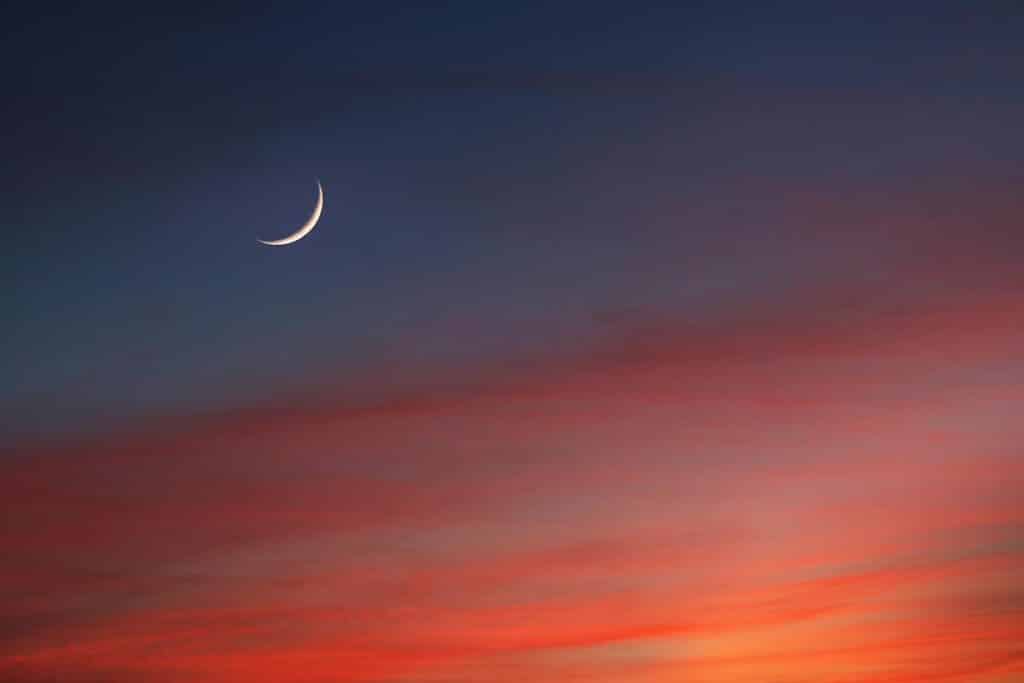
Ever wonder why all the Jewish holidays, like Rosh Hashanah and Yom Kippur, fall on different days every year, while Christian holidays such as Christmas and Easter remain fixed? Well, it’s not just to keep the Jewish community guessing.
The Jewish calendar uniquely blends both lunar and solar elements. Unlike the widely-used Gregorian calendar — rooted in Catholicism and based on the solar cycle — the Hebrew calendar skillfully aligns with both lunar phases and the solar year.
While we won’t delve deep into the nuances of the Hebrew calendar here, this brief overview will help you grasp the essence of Rosh Chodesh. It signifies both the dawn of a new month and the intricate balance between the lunar and solar timekeeping of the Jewish calendar.
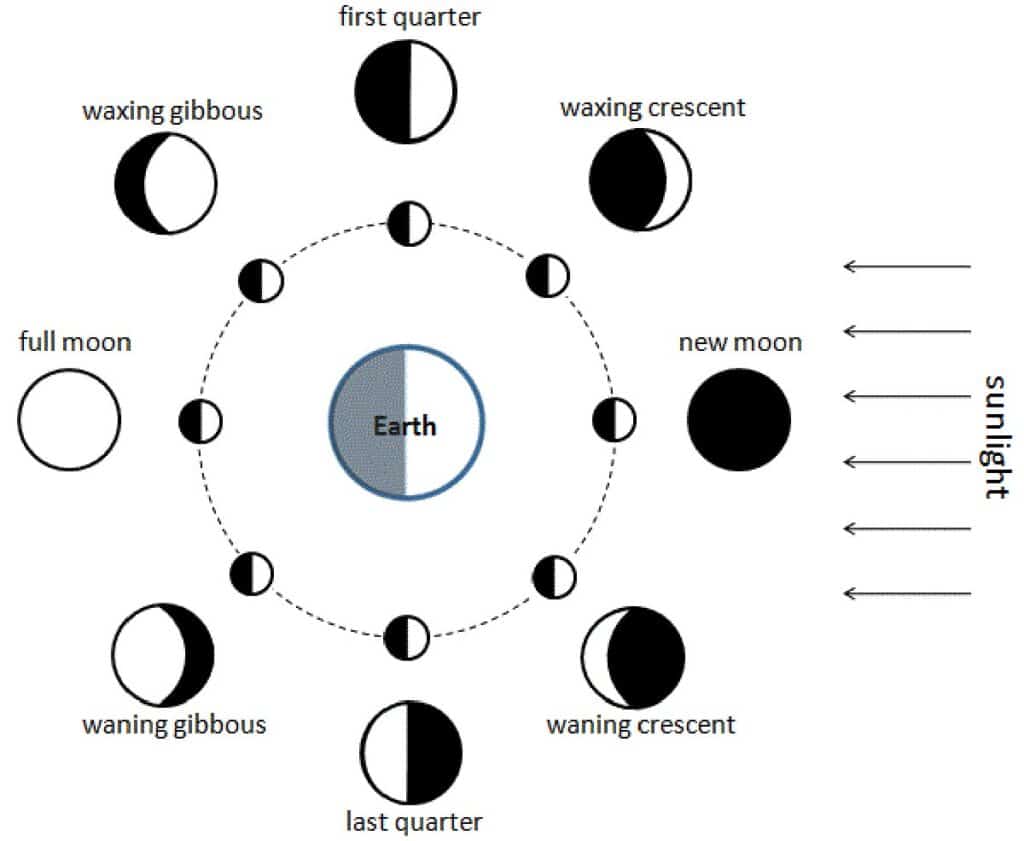
The Hebrew calendar has twelve lunar months, each spanning either 29 or 30 days. These months are Nisan, Iyar, Sivan, Tamuz, Av, Elul, Tishrei, Heshvan, Kislev, Tevet, Shvat, and Adar. On leap years, an extra month, Adar 2, follows Adar.
Jewish months are based on the lunar cycle, and so are the dates for Jewish holidays. However, to ensure these holidays remain in their agriculturally significant seasons, they are also aligned with the solar year.
The lunar year lasts approximately 354 days, whereas the solar year is about 365 days — a difference of roughly 11 days. To reconcile this discrepancy, the Hebrew calendar introduces adjustments such as adding an extra month, Adar II, during certain leap years.
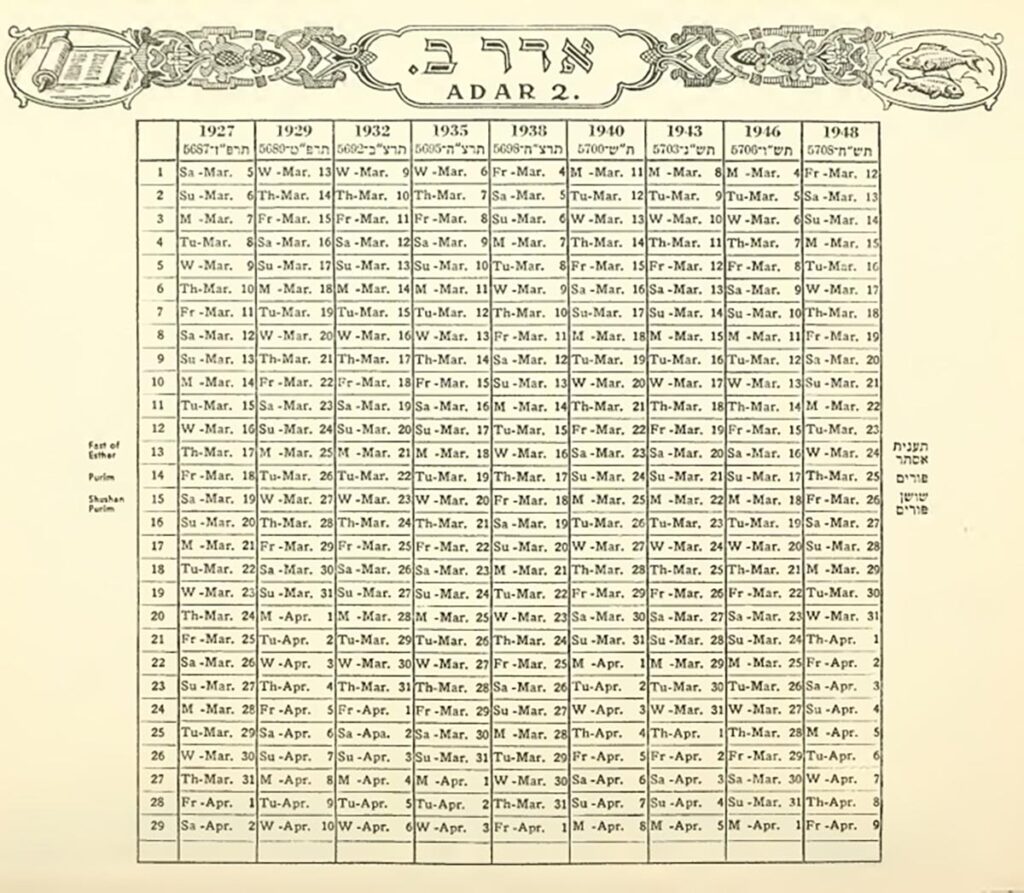
Additionally, some months might have their length varied by a day in specific years to ensure that certain holidays don’t fall on particular days of the week. Without these regular adjustments, Jewish holidays would slowly drift away from their intended seasons.
When is Rosh Chodesh observed?
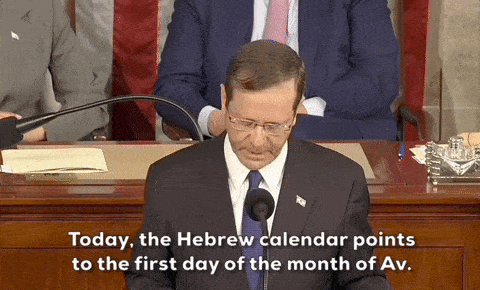
The observance of Rosh Chodesh, which marks the beginning of the new month, alternates depending on whether the previous month is 29 or 30 days long. Here’s how it works.
For months that span 30 days, Rosh Chodesh extends over two days: it begins on the 30th day of the current month and continues on the first day of the new month.
Conversely, after a month that has only 29 days, Rosh Chodesh is observed solely on the first day of the following month. Below is a chart outlining the lengths of each Hebrew month and Rosh Chodesh:
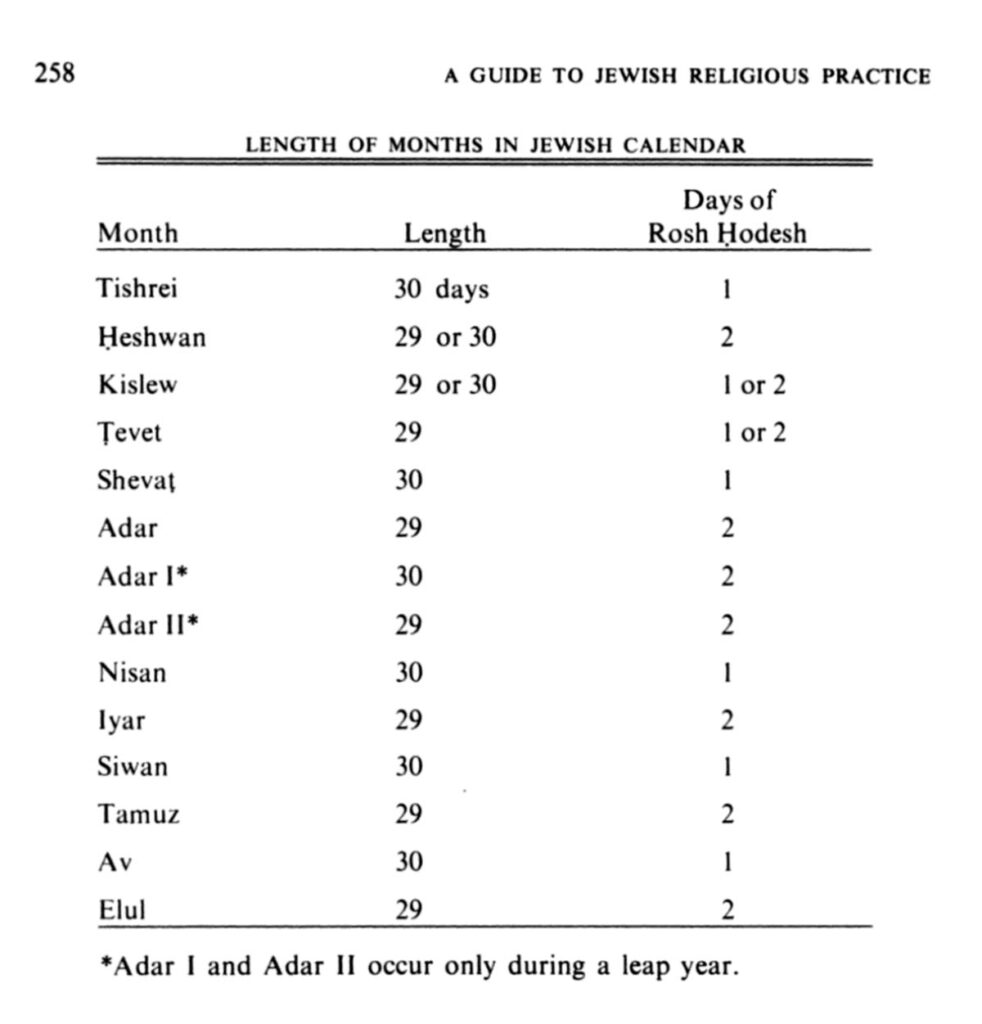
Like all Jewish holidays, Rosh Chodesh starts at sundown on the day prior.
How to greet someone on Rosh Chodesh
On Rosh Chodesh, it is customary to wish people a “chodesh tov,” meaning “a good month.”
How is Rosh Chodesh celebrated?
While Rosh Chodesh is now considered a minor festival, it still holds significance in contemporary Jewish practice. Today, Rosh Chodesh is mainly marked through specific prayers that connect the Jewish community to its calendar and heritage. (Continue reading to learn about the blessings for Rosh Chodesh.)
Some celebrate Rosh Chodesh by eating a family meal together and wearing festive clothes. The Shulchan Arukh (Orach Chayim 419) states, “It is a mitzvah to feast in honor of Rosh Chodesh.” Some suggest that this tradition recalls the celebrations held in honor of witnesses who journeyed to Jerusalem to attest to the sighting of the new moon.
In modern times, there has been a resurgence of Rosh Chodesh observance among Jewish women — read more below.
The origins of Rosh Chodesh
The foundation of the Hebrew Calendar is established in Sefer Shemot (the Book of Exodus). As the Israelites prepare to leave Egypt, God commands them to mark the months of the year:
“This month shall mark for you the beginning of the months; it shall be the first of the months of the year for you” (Shemot/Exodus 12:2). Significantly, this was the first mitzvah (commandment) given to the entire Jewish people.
In ancient times, Rosh Chodesh held notable significance and was observed with deep solemnity. It was marked by special sacrifices and the sounding of trumpets at the Sanctuary (Bamidbar/Numbers 10:10, 28:11-15). Families came together in festivity and work ceased (1 Samuel 20:5, Amos 8:5).

In its earliest form, the Hebrew calendar lacked a set method to pinpoint Rosh Chodesh. Instead, the determination fell to the Sanhedrin, a preeminent Jewish court. Their decision hinged on the accounts of two reliable witnesses who attested to seeing the new moon.
The Mishnah (Rosh Hashanah 2:5) describes this process: “After the witnesses have been examined and their testimony accepted, the head of the court says: ‘It is sanctified.’ And all the people respond after him: ‘It is sanctified; it is sanctified.’”
Once confirmed, the news would be relayed across Israel and Babylonia using fire signals from hilltop to hilltop. The process was like an ancient relay race. When a new moon’s arrival was verified, an individual would ascend the Mount of Olives in Jerusalem, set a pole on fire and wave it until someone on another hill saw it and continued the signal.
This system had to be reformed when Samaritans started lighting fires on hilltops to mislead Jews. As a solution, envoys were dispatched from Jerusalem to communicate the news directly (Mishnah Rosh Hashanah 2:2).
By around 360 C.E., Hillel II, a prominent Jewish scholar, introduced reforms to the Jewish calendar. He established a fixed system for determining months and holidays, making it less dependent on moon sightings and more predictable year after year. Following these changes, it became customary to announce the arrival of Rosh Chodesh after the Torah reading on Shabbat.
The significance of Rosh Chodesh
Rosh Chodesh represents a time of personal renewal and redemption.
According to the renowned 19th-century German Rabbi Samson Raphael Hirsch, Rosh Chodesh reflects the Jewish people’s spirit of resilience and renewal:
“The waxing and waning of the moon remind the pious of Israel’s renewal. Even in its darkest wanderings, Israel, like the moon itself, is never lost; and Israel’s return into the light is assured, so long as its children loyally cling to the paths which God’s word has shown unto them.”
Rabbi Isaac Klein, paraphrasing Rabbi Abraham Millgram, described the monthly reappearance of the moon as “the symbol of Israel’s redemption. Just as the moon emerges from its total eclipse into brightness, so will Israel be redeemed.”
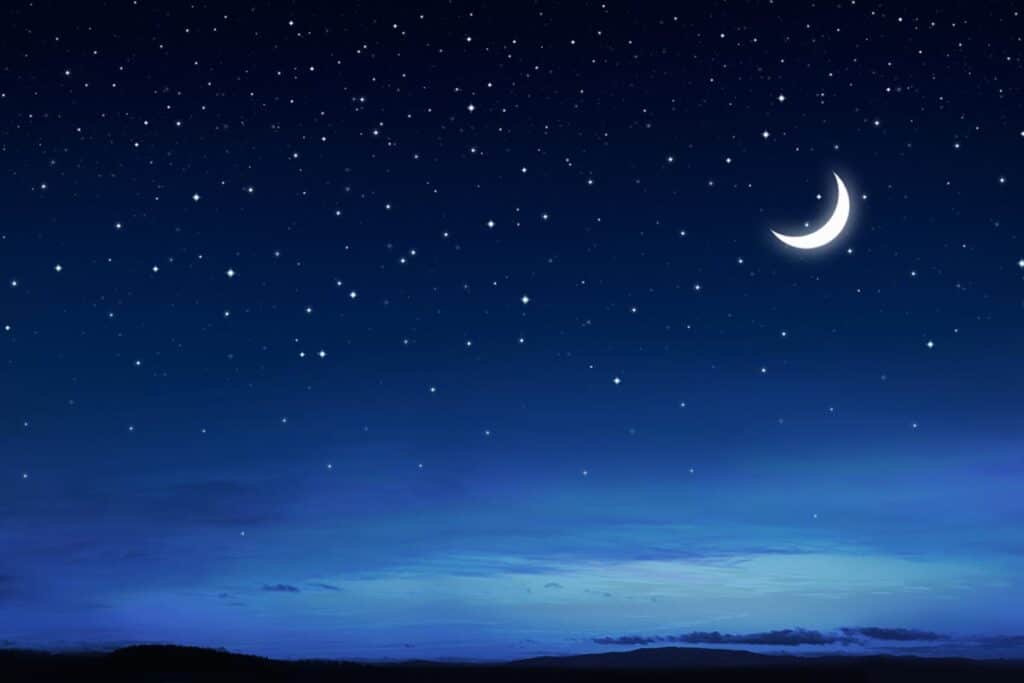
Meanwhile, in the 16th century, the famous kabbalist Rabbi Moses Cordovero introduced the tradition of fasting on the day preceding Rosh Chodesh. He termed it Yom Kippur Qatan, emphasizing Rosh Chodesh as a day for atonement and renewal.
On a basic level, Rosh Chodesh invites us to recognize and honor the passage of time. Rabbi Jonathan Sacks underscored the unique way Judaism navigates time, blending both lunar and solar measures: “Christianity uses a solar calendar, Islam a lunar one. Judaism uses both.”
Rosh Chodesh has also traditionally been a time for communal gathering and connection. The great medieval scholar Maimonides (Rambam) emphasized that the sanctification or declaration of the new moon was uniquely tied to the land of Israel (Mishneh Torah, Hilchot Kiddush HaChodesh 1:8).
Historically, those observing the festival would make pilgrimages to Jerusalem, underscoring the significance of community and centrality of the land of Israel in Jewish tradition.
The connection between women and Rosh Chodesh
The celebration of the new moon holds a unique and profound connection for Jewish women. Although the entire Jewish community was instructed to observe Rosh Chodesh, it has become especially meaningful for women over time.

What’s behind this connection? The midrash (Pirkei d’Rabbi Eliezer 45) attributes it to the biblical episode of the golden calf. When the men decided to create the golden calf, women displayed unwavering faith and courage by refusing to participate and withholding their jewelry for use in crafting the idol. In recognition of their bravery and faith, they were granted the gift of Rosh Chodesh — a day of rest, reflection, and renewal every month.
Another perspective draws upon the natural link between the moon’s phases and women’s menstrual cycles. Penina Adelman, a pioneer in modern Rosh Chodesh rituals for women, highlighted that the Hebrew words “Roshei Chodshim” (heads of the months) and “Rechem” (womb) share the same letters.
Rosh Chodesh has also traditionally been associated with the Shekhinah, the feminine divine presence within Jewish mysticism. For instance, in the Talmud (Sanhedrin 42a), Rabbi Yohanan is quoted as saying: “Anyone who blesses the new month in its proper time, it is as if he greets the face of the Divine Presence (Shekhinah).”
Throughout history, Jewish women have held unique customs and traditions surrounding Rosh Chodesh. The Talmud (Megillah 22a) mentions that it was customary for women to refrain from work on this day, a practice that was observed by many Jewish communities in medieval times. Instead, women would often engage in communal activities, including feasting and charity.

Between the 16th and early 20th centuries, Jewish women in Eastern Europe crafted heartfelt Rosh Chodesh techinot — personal Yiddish prayers — capturing their profound spiritual connection to the day.
In modern times, there has been a resurgence in Rosh Chodesh observance, particularly among Jewish women who have formed dedicated groups.
In her 1996 book, “Miriam’s Well: Rituals for Jewish Women Around the Year,” Penina Adelman offered insights into modern women’s Rosh Chodesh groups and provided a framework for creative Rosh Chodesh rituals. These groups, organized by women and congregations, meet monthly to sing, pray, connect and study.
Organizations like At The Well have helped make Rosh Chodesh groups accessible to more women. They host monthly “Well Circles,” fostering a sense of community and spiritual connection. Each Hebrew month, the organization releases a “Moon Manual” filled with resources, activities, and articles relating to the themes and holidays of each month.
Birkat Hachodesh (Blessing of the New Month)
On the Shabbat preceding Rosh Chodesh, a special prayer known as Birkat HaChodesh or Blessing of the New Month is recited following the Torah reading. The congregation prays for a month that brings goodness, blessing, peace, good health, and more. The prayer also serves to announce the day on which the new month will begin.
יְהִי רָצון מִלְּפָנֶיךָ ה’ אֱלהֵינוּ וֵאלהֵי אֲבותֵינוּ. שֶׁתְּחַדֵּשׁ עָלֵינוּ אֶת הַחדֶשׁ הַזֶּה לְטובָה וְלִבְרָכָה. וְתִתֶּן לָנוּ חַיִּים אֲרוּכִּים. חַיִּים שֶׁל שָׁלום. חַיִּים שֶׁל טובָה. חַיִּים שֶׁל בְּרָכָה. חַיִּים שֶׁל פַּרְנָסָה. חַיִּים שֶׁל חִלּוּץ עֲצָמות. חַיִּים שֶׁיֵשׁ בָּהֶם יִרְאַת שָׁמַיִם וְיִרְאַת חֵטְא. חַיִּים שֶׁאֵין בָּהֶם בּוּשָׁה וּכְלִמָּה. חַיִּים שֶׁל עשֶׁר וְכָבוד. חַיִּים שֶׁתְּהֵא בָנוּ אַהֲבַת תּורָה וְיִרְאַת שָׁמַיִם. חַיִּים שֶׁיִּמָלְאוּ מִשְׁאֲלות לִבֵּנוּ לְטובָה אָמֵן סֶלָה:
מִי שֶׁעָשה נִסִּים לַאֲבותֵינוּ וְגָאַל אותָם מֵעַבְדוּת לְחֵרוּת. הוּא יִגְאַל אותָנוּ בְּקָרוב וִיקַבֵּץ נִדָּחֵינוּ מֵאַרְבַּע כַּנְפות הָאָרֶץ. חֲבֵרִים כָּל יִשרָאֵל וְנאמַר אָמֵן:
ראשׁ חדֶשׁ פלוני יִהְיֶה בְּיום פלוני הַבָּא עָלֵינוּ וְעַל כָּל יִשרָאֵל לְטובָה:
יְחַדְּשֵׁהוּ הַקָּדושׁ בָּרוּךְ הוּא עָלֵינוּ וְעַל כָּל עַמּו בֵּית יִשרָאֵל בְּכָל מָקום שֶׁהֵם. לְטובָה וְלִבְרָכָה. לְששון וּלְשמְחָה. לִישׁוּעָה וּלְנֶחָמָה. לְפַרְנָסָה טובָה וּלְכַלְכָּלָה. לְחַיִּים וּלְשָׁלום. לִשְׁמוּעות טובות. וְלִבְשורות טובות. בחורף – וְלִגְשָׁמִים בְּעִתָּם. וְלִרְפוּאָה שְׁלֵמָה. וְלִגְאוּלָה קְרובָה וְנאמַר אָמֵן:
May it be Your will, Adonai our God and God of our ancestors, grant that this coming month bring us goodness and blessing, and bestow on us a long life, a life that is peaceful, a life that is good, a life that is blessed, a life with proper sustenance, a life with physical vitality, a life conscious of heaven’s demands and wary of sin, a life free of shame and reproach, a life of abundance and honor, a life of love of Torah, conscious of heaven’s demands, a life in which the worthy desires of our hearts are fulfilled. Amen.
May God who wrought miracles for our ancestors, redeeming them from slavery to freedom, redeem us soon and gather our dispersed from the four corners of the earth. May the entire people Israel be united in friendship, and let us say: Amen.
The new month of ____ will begin on ____. May it hold blessings for us and for all the people Israel.
May the Holy One bless this new month for us and for the entire people, the house of Israel, with life and peace (Amen), joy and gladness (Amen), deliverance and consolation. And let us say: Amen.
Other blessings and practices for Rosh Chodesh
- Yaaleh Veyavo (“May [our remembrance] rise and be seen”): During Rosh Chodesh, the “Yaaleh Veyavo” prayer is added to the Amidah (one of the most important Jewish prayers that is recited multiple times a day in traditional services) and into the blessing after meals, Birkat HaMazon. This prayer seeks God’s blessings and remembrance for the new month.
- Half-Hallel: A collection of Tehillim/Psalms (113-118) is recited as an expression of gratitude and praise to God on the new month. On Rosh Chodesh, a shortened version known as “half-Hallel” is recited.
- Torah Reading: On Rosh Chodesh, a specific Torah portion, Bamidbar/Numbers 28:1-15, is read during morning services. This portion describes the sacrifices offered in the Temple on Rosh Chodesh. If Rosh Chodesh falls on Shabbat, there is a special Haftarah reading, Isaiah 66: 1-24, which speaks of the new moon.
Originally Published Sep 9, 2023 10:29PM EDT
